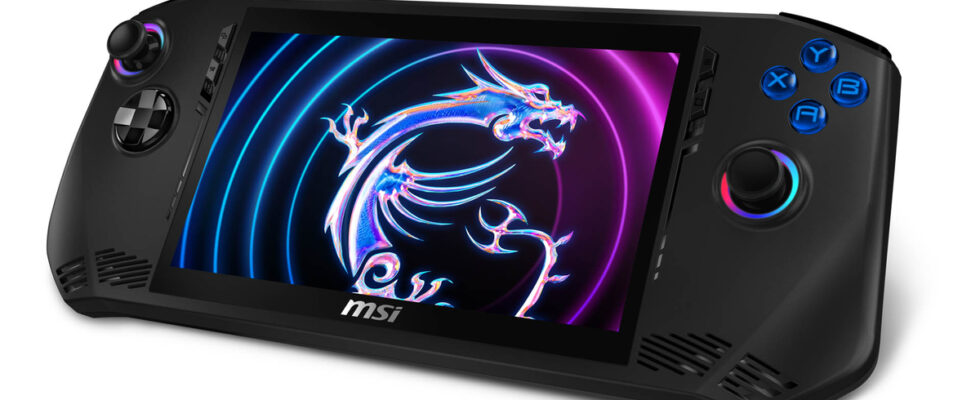After the Asus ROG Ally and the Lenovo Legion Go, a third thief joins the race to dethrone the Steam Deck: the Taiwanese MSI. With its Claw – literally “claw” – the Asian manufacturer takes up most of the codes of these PC consoles initially inspired by the Nintendo Switch. Namely a Windows 11 console that is certainly portable, but with a large 7-inch screen.
No Oled for MSI, but a 120 Hz IPS panel with Full HD definition (1920 x 1080 px). With a peak brightness of 500 cd/m² (or nits for fans of American units), the panel promises good readability in broad daylight, even if it cannot offer the same depth of blacks as the competition. Given its 7-inch size, its Full HD definition is much more relevant than that of the Legion Go, which is also IPS, but which its native definition (2560 x 1600 px) and its higher frequency (144 Hz) make it more energy-consuming .
With this choice of panel, we must also and above all highlight the more original choice of the processor. While all traditional players are equipped with AMD chips (1), MSI has opted for Intel. At the heart of the machine, we find a Core Ultra 7 processor 155H, one of the most efficient chips of the Meteor Lake generation which we have spoken to you about in detail. A datasheet notice from MSI displaying “up to Core Ultra 7” suggests that the Taiwanese is already thinking about variations – undoubtedly as for the Z1 and Z1 Extreme versions of Asus’ ROG Ally. In terms of graphics performance, the first tests of the Core Ultra 7 155H show levels regularly surpassing the Radeon 780M from AMD, which allows us to hope for image quality and/or fluidity superior to the competition. But also, hopefully, a potential better energy efficiency when we lower the watts in order to play the titles for longer the least greedy.
In any case, this console PC will have the merit of allowing AMD and Intel to compete in the field of mobile gaming, which had only happened through niche machines signed GPD and other Aya . We will therefore be able to judge the performance of the different chips with target TDPs – the Core Ultra 7 155H is qualified for different TDPs, with an average threshold at 28 W (even if MSI has not yet communicated the selectable values).
53 Wh to (try to) last longer
For this first version of the console PC, MSI is also highlighting its choice of 53 Wh battery, which makes it the battery with the highest capacity on the market… In any case, the Steam Deck OLED is not so far with a jump from 40 Wh to 50 Wh — and a lower definition as well as a less energy-consuming chip. If the Legion Go doesn’t seem far away with 49.2 Wh, its screen definition weighs it down somewhat. Ultimately, it is compared to the ROG Ally (40 Wh) that the Claw would have the most chance of making a difference.
Will Intel’s chip be power efficient in the pure gaming scenarios the Claw is designed for? The answer will arrive after the first tests. In any case, it is above all energy efficiency that gamers are looking for to go beyond the 2 hours of play promised by MSI’s console.
Hall effect joysticks and gaming comfort
When it comes to controls — critical for a console! — MSI, like Lenovo, used so-called Hall effect joysticks. Two components that are more precise than traditional models, and which protect players from a potential drift effect (like on the Switch) by eliminating mechanical wear. It is in fact a difference in magnetic field which controls the movements and not friction, eliminating the risk of mechanical breakdown.
In terms of handling, the 675 g machine promises great comfort not only through its geometric design or its materials, but also due to a cooling system which prevents overheating of the palms of the hands. Like Asus, MSI does without a front webcam and uses a fingerprint reader to unlock the machine. And like its competitors, it uses two software for Windows: a technical control center (MSI Center M) and a gaming platform centralizer (MSI App Player). Tools which, casually, will greatly influence the overall software ergonomics. Because, let’s remember again, this is above all a PC running Windows 11, an operating system which was not designed for this use. If these consoles have the strong point of being able to take advantage of the enormous game library of this platform, ergonomics is generally the weak point of these machines compared to the Steam OS of the Steam Deck.
For now, MSI has not yet announced a price or release date for its Claw A1M.
